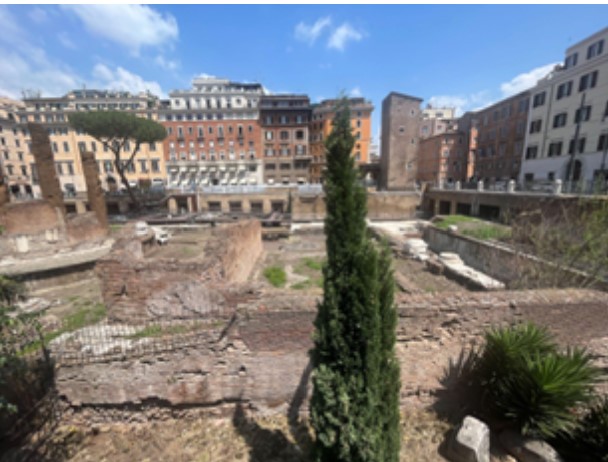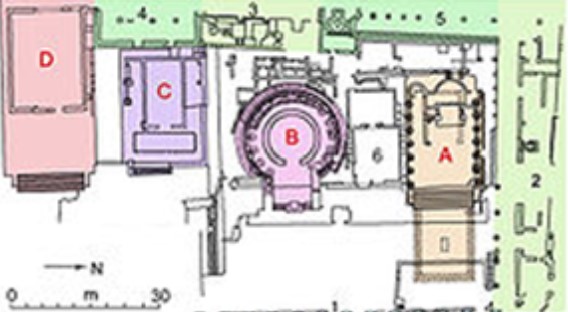Tags
Abbey Staats, BGSU History, BGSU Study Abroad, Casey Stark, Jo Enger Arthur Scholarship for Study Abroad, Largo Argentina, Roma Aeterna, Rome, Undergraduate
By: Abbey Staats, BGSU Roma Aeterna 2023 Student
The Largo di Torre Argentina, or Largo Argentina, holds immense significance as a testament to Rome’s ancient past. The temples within the complex provide valuable insights into the religious practices and beliefs of the Roman Republic. Largo Argentina consists of four Republican-era temples dedicated to various religious figures that were important during this time. However, the space is most notable for being the location where Julius Caesar was assassinated. Now, one of the critical features of the space is the Torre Argentina Cat Sanctuary which feeds and cares for stray cats around Rome. From above, the space seems almost ordinary in a city like Rome where there are ruins on almost every block but when considering and studying the history of this space, it is quite amazing.
All of the temples are labeled Temple A, B, C, and D since the dedications on them are incomplete. While it’s hard to tell how old each temple was and who it was dedicated to because of the age of this space, historians believe they have a good understanding of who each altar was for and when each comes from. Temple A (shown at the top of Figure 1) comes from 241 BCE and was likely a dedication to Juturna, a water nymph and the goddess of fountains, wells, and springs (Barber and Macadam, 386). According to myth, Juturna was turned into a water nymph by Jupiter and given a sacred well in Lavinium and near the Temple of Vesta in the Forum Romanum. There are also the remains of a small public latrine behind Temple A that is somewhat visible.
Temple B was a temple dedicated to Fortuna, the goddess of fortune and a personification of luck. She was also strongly connected with fertility which is why she was associated with the bounty of the soil and the fruitfulness of women (Britannica). This temple is the most recent temple and one of the most well-maintained with six of its columns and the stairs surviving (Barber and Macadam, 387). This temple stands out the most out of all of the temples and makes me wonder how the pillars are mostly intact and still standing after being buried for so many years. The excavation process must have been very tedious.
Temple C, which is the oldest coming from around the 4th century BC, was possibly dedicated to Feronia, an ancient deity (Barber and Macadam, 387). Not much is known about Feronia but one source says, “Some consider her to have been the goddess of liberty, because at Terracina slaves were emancipated in her temple” (Encyclopedia Mythica). Something interesting about this temple specifically was that it was rebuilt in the Imperial Era as a result of a fire.
Temple D was the largest of the temples and lies partly under Via Florida. As you can see in Figure 1, only a small portion is showing and there aren’t any plans for further excavation of this temple as of now. This temple was a dedication to Lares Permarini, protectors of sailors and navigation, and is likely from the 2nd century BCE (Barber and Macadam, 387). The Lares played an important role in the day-to-day lives of Romans, “The Lares were gods who protected the people, the house, and the activities. Each family had its Lares who represented the souls of the family members departed and in any Domus there was a lararium where they celebrated the cult of their Lari” (“Templum Lares Permarini”). As for the Lares Permarini, they were supposed to protect Romans when they were away from Rome and were often placed on the prow of a ship to protect those on the ship (“Templum Lares Permarini”).

These four temples were uncovered in the years 1926- 1929 after some medieval structures that had covered the archaeological remains were demolished (Marra, et. al, 642). After uncovering these structures, there was some debate among the owner of the property and the archeologists who wanted to continue the excavation. Following permission from the Head of Government in 1928, the site was excavated in “record time” and on April 21st, 1929, the 2682nd birthday of Rome, the “Foro Argentina” was inaugurated. (Gatti Di Roma, A Bit of History).
In 55 BC, the famous Roman general Pompey the Great built a grand theater adjacent to the temples, known as Pompey’s Theater. This theater was one of the largest in Rome and was used not only for entertainment purposes but for religion, leisure, and politics. These two spaces combined help give a viewer a grasp of how large many of these structures were. While now they don’t even seem connected, it shows how big the Theatre of Pompey once was. Walking from one space to the other just demonstrated to me how large ancient Rome was making it even more impressive.
The assassination of Julius Caesar took place just behind Temple B in the Curia of Pompey. As mentioned, the Theatre of Pompey was used for politics as well thus it makes sense why Caesar was murdered at the Curia of Pompey, one of the meeting halls for the senate at the entrance to the Theatre of Pompey (Coopey). For the reason for his murder, one source says, “The crime committed out of fear that the dictator would proclaim himself king was organized during the holiday of the Ides of March.” (Lopez and Gerardo). However, a different source brings to light a variety of different reasons that include both Caesar’s doings but also the political motives of his assassins, “For better or worse, the Roman Republic was what it was; a pseudo oligarchy dominated by the rich and well connected. Caesar did threaten this traditional power base with his hopes to dominate it. He violated Roman ideals about the Republic, even if those ideals are not what modern historians believe that they should be” (Thompson, 17). The complicated assassination is one that bring a lot of people to Torre Argentina and certainly interested the group we were with.

One of the most notable aspects of this space is the Torre Argentina Cat Sanctuary which is located in the ruins. After its excavation in 1929, cats started taking residence in the ruins with local “cat ladies” feeding them regularly. One of these cat ladies was an Italian filmstar, Anna Magnani, who would spend her breaks feeding and petting the cats while she worked at Teatro Argentina which borders the ruins. Finally, in 1993, two friends Lia and Silvia started helping a woman who was feeding and neutering all of the cats by herself and that started Torre Argentina Cat Sanctuary (Gatti Di Roma, Who We Are). Now hundreds of cats per year are taken care of and given support by tourists and locals which has made this space even more popular. The cats around Largo Argentina help draw in more tourists especially after one of the shelter cats had a book called Chiamatemi Romeo written about his adventures living in Largo Argentina from the time of Caesar to more recent life.
The Largo Argentina site didn’t open to tourists until very recently. It was just in February of 2019 when the Mayor of Rome, Virginia Raggi, announced that it would soon be open to tourists. They are in the process of creating paths that will be illuminated at night that weave you in and around the temples so you don’t have to look down at it like a balcony. Raggi called the space “One of the most evocative places in Rome, a treasure chest in the heart of the city. Imagine, this archaeological complex houses four temples dating from between the third and second centuries BC” (Mayor Raggi Via Facebook). Surprisingly (or not), the people making it happen is the luxury jewelry company, Bulgari. Interestingly enough, Bulgari also financed the €1.5 million restoration of the Spanish Steps. The Largo Argentina was supposed to be open for tourists to walk around a year after the announcement but it was closed when we visited on May 23, 2023. The good news is that according to Weir, it is set to officially open on June 20, 2023!
Largo Argentina’s archaeological significance extends beyond its temples and theater. Excavations at the site have uncovered a wealth of artifacts, including statues, inscriptions, and everyday objects, offering valuable insights into the lives and culture of ancient Romans. The discovery of these artifacts has contributed to a deeper understanding of Roman history and has enriched the knowledge gained of the city’s past. One thing stands out when considering the standing impression this site gives to a visitor: Ancient Romans had a strong connection to their religion and felt it important to build temples for those they wanted to honor and receive blessings from. Largo Argentina serves as a testament to the architectural abilities of Ancient Romans as well as a symbol of the values that Ancient Romans held.
Works Cited
Coopey, Ewan. “Nice Theatre, but Didn’t They Kill Caesar Here?” MQ Ancient History: City of Rome Blog, Macquarie University Department of Ancient History – City Of Rome, 24 Feb. 2019, ancient-history-blog.mq.edu.au/cityOfRome/Theatre-of-Pompey.
“Feronia.” Encyclopedia Mythica. Encyclopedia Mythica, 3 Mar. 1997. Web. 20 Jun. 2023.
https://pantheon.org/articles/f/feronia.html.
“Largo Di Torre Argentina.” Wikipedia, Wikimedia Foundation, 8 Aug. 2022,
en.wikipedia.org/wiki/Largo_di_Torre_Argentina.
López, Beltrán and Luis Gerardo. “Largo Di Torre Argentina, Donde Julio César Fue Asesinado
En Roma Será Lugar Turístico En 2022.” El Debate, Apr 14, 2021. ProQuest, https://www.proquest.com/newspapers/largo-di-torre-argentina-donde-julio-césar-fue/docview/2513132176/se-2. Translated into English by ProQuest.
Macadam Alta, and Annabel Barber. Rome. 12th ed., Blue Guides Limited, 2020.
Marra, F., et al. “The Geochemical Fingerprint of Tufo Lionato Blocks from the Area Sacra Di
Largo Argentina: Implications for the Chronology of Volcanic Building Stones in Ancient Rome: Geochemical Fingerprint of Tufo Lionato from Largo Argentina, Rome.” Archaeometry, vol. 60, no. 4, 2018, pp. 641–659, https://doi.org/10.1111/arcm.12343.
“Rome and Art.” Templum Lares Permarini, 28 June 2016,
www.romeandart.eu/en/art-lares.html.
“Rome to Open Largo Argentina Site to Visitors Thanks to Bulgari.” Wanted in Rome, 14 Apr.
2021, www.wantedinrome.com/news/rome-to-open-largo-argentina-site-to-visitors-thanks-to-bulgari.html.
Staats, Abbey. Photograph of Temple A and B at Largo Di Torre Argentina. 23 May 2023.
Staats, Abbey. Photograph of Cats at Torre Argentina Cat Sanctuary. 20 May 2023.
The Editors of Encyclopaedia Britannica. Britannica. “Ancient Religions and Mythology”. 12 Apr. 2019, https://www.britannica.com/topic/Fortuna-Roman-goddess.
“Torre Argentina Cat Sanctuary.” Gatti Di Roma, 1 Aug. 2018,
www.gattidiroma.net/web/en/a-little-bit-of-history/.
Thompson, Jeffery A. “Sic Semper Tyrannis: Justification of Caesar’s Assassination .” Western
Oregon University, 2009, https://wou.edu/history/files/2015/08/Jeffrey-Thompson-HST-499.pdf.
Weir, Keith. “Rome to Open Ancient Square Where Julius Caesar Was Killed.” Reuters, 19 June
2023, www.reuters.com/world/europe/rome-open-ancient-square-where-julius-caesar-was-killed-2023-06-19/.


